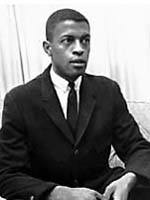David Richmond (activist) facts for kids
Quick facts for kids
David Richmond
|
|
|---|---|

Richmond c. 1960
|
|
| Born | April 20, 1941 |
| Died | December 7, 1990 (aged 49) Greensboro, North Carolina, US
|
| Resting place | Carolina Biblical Gardens, Jamestown, North Carolina |
| Alma mater | North Carolina A&T State University |
| Spouse(s) | Yvonne Bryson |
| Children | 3 |
David Leinail Richmond (born April 20, 1941 – died December 7, 1990) was an important civil rights activist. He is best known as one of the Greensboro Four. These four young men helped start a big change in America.
David was a student at North Carolina A&T when the famous Greensboro protests began. He later received an award for his work. This was the Levi Coffin Award for leadership in human rights in 1980. After his death in 1990, he was given an honorary doctorate degree from North Carolina A&T.
Contents
Who Was David Richmond?
David Leinail Richmond was born in Greensboro, North Carolina, on April 20, 1941. He grew up there and went to James B. Dudley High School. David was a popular student in high school. He played many sports and joined several clubs. In 1959, he even set a state record in the high jump.
After high school, David went to North Carolina A&T State University. He studied business and accounting. During his second semester, David and his friends took part in a very important protest. This protest helped change history.
The Greensboro Sit-Ins
On February 1, 1960, David Richmond and three other freshmen from A&T walked to a Woolworth store. These friends were Ezell Blair Jr., Franklin McCain, and Joseph McNeil. They bought some items from a counter where everyone could shop. Then, they sat down at the "whites only" lunch counter.
The staff refused to serve them because of their race. David and his friends stayed there until the store closed. They left, but they planned to come back the next day. This was the start of the famous Greensboro sit-ins.
What Happened at Woolworth's?
Joseph McNeil, Franklin McCain, David Richmond, and Jibreel Khazan (Ezell Blair Jr.'s later name) asked for service. This happened on February 1, 1960, at the Woolworth's lunch counter. They were told to use a different "stand-up counter" meant for black people. The young men explained they had already been served that day. They even showed their receipts.
An older black woman who worked there suggested they follow the rules. The manager also told them to move. But the students refused. They had decided not to trust adults who had not protested these unfair rules before. A police officer came, but he didn't know what to do. The students were just sitting quietly and politely disagreeing. Their peaceful actions surprised him.
Franklin McCain remembered an older white woman talking to him. She said she was disappointed. When he asked why, she said she was disappointed it took them so long to do something like this. The students kept sitting until the manager closed the store early. The boys felt they had won. They had feared being arrested or hurt.
How the Movement Grew
The Greensboro Four were not the first to protest segregation peacefully. Seven people had done something similar in Durham, North Carolina, three years earlier. But the Greensboro protest grew quickly. It also got a lot of attention. A photo of the four young men was taken during that first protest. This photo helped spread the word.
Within four days, hundreds of students joined the protest. They came from A&T, UNC Greensboro, Bennett College, and even Dudley High School. By the second week, thousands of students were protesting in many cities across the United States.
On July 25, 1960, just five months after the Greensboro Four's first step, the Woolworth's store served its first African-American customers. This led to many public places across the country ending segregation. Many people see this as the true beginning of the American Civil Rights Movement.
Later Life and Legacy
After the sit-ins, David Richmond found it hard to keep up with his schoolwork. He eventually left North Carolina A&T. He later worked as a counselor-coordinator in Greensboro. David received threats and moved to Franklin, North Carolina, in the mountains.
He later returned to Greensboro to care for his parents. It was hard for him to find a job because some people saw him as a "troublemaker." He eventually found work as a janitor at the Greensboro Health Care Center.
David Richmond's Death and Honors
David Richmond felt he could have done more to make the world better. He struggled with sadness before he passed away. He died from lung cancer on December 7, 1990, at age 49.
At his memorial service, North Carolina A&T gave him an honorary doctorate degree. He also received the Levi Coffin Award in 1980. This award was for his leadership in human rights in Greensboro. In 2010, he was given the James Smithson Bicentennial Medal from the Smithsonian Institution.
In 2002, North Carolina A&T honored David Richmond and the other three members of the A&T Four. They built a statue of them on campus. Also, residence halls at the university are named after these four brave men.
Family Life
David Richmond was married and divorced twice. He had three children. His daughter, Angela Morton Obi, was born in 1959. She was his child with his high school girlfriend, Dorothy Harrison. With his first wife, whom he married in college, he had two children: David "Chip" Richmond Jr. and Hadelyn (Lynn) Richmond Massenburg. His son, Chip, played football for Wake Forest University. David and his second wife, Yvonne Bryson, did not have children together.
Images for kids


